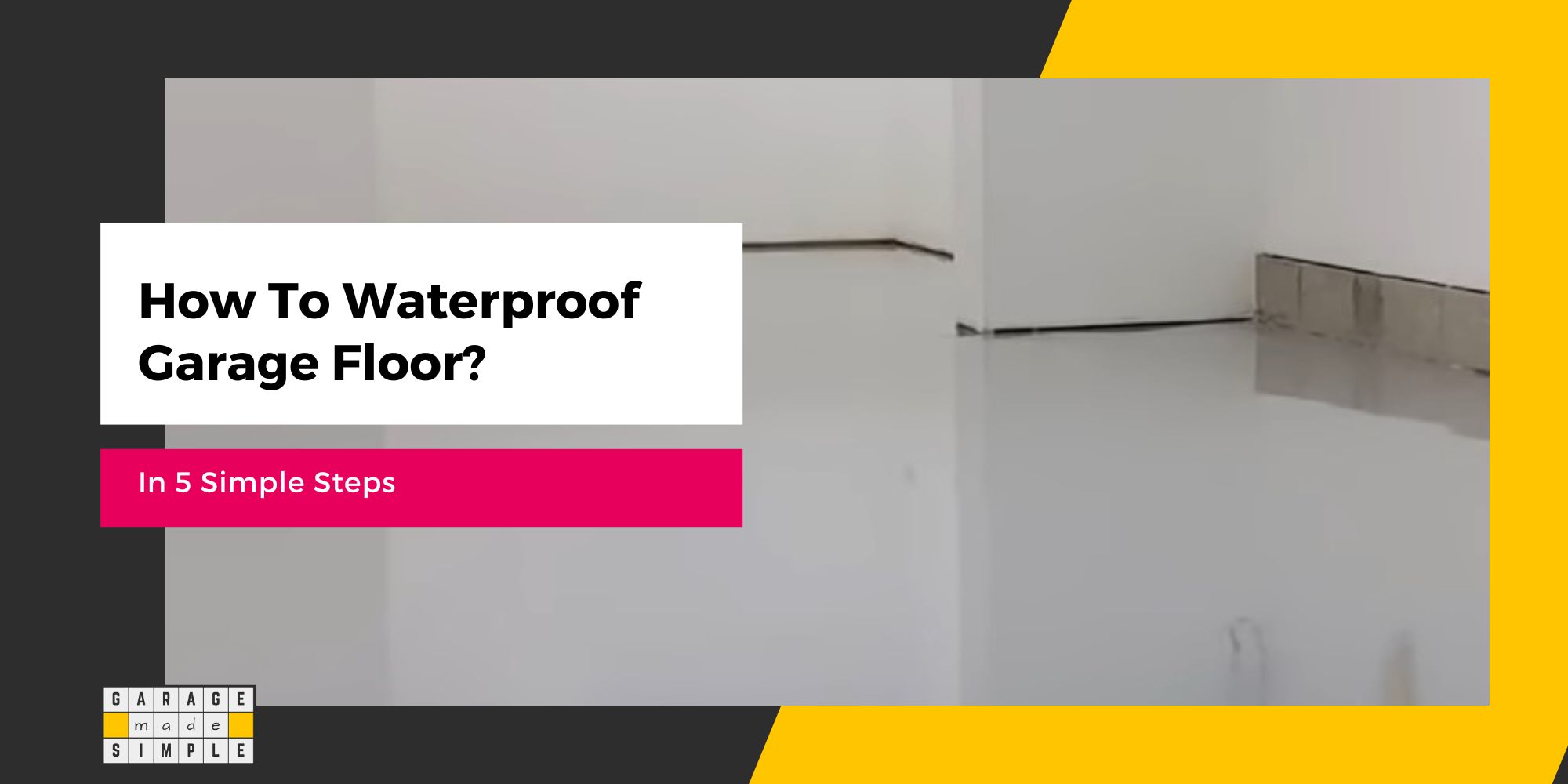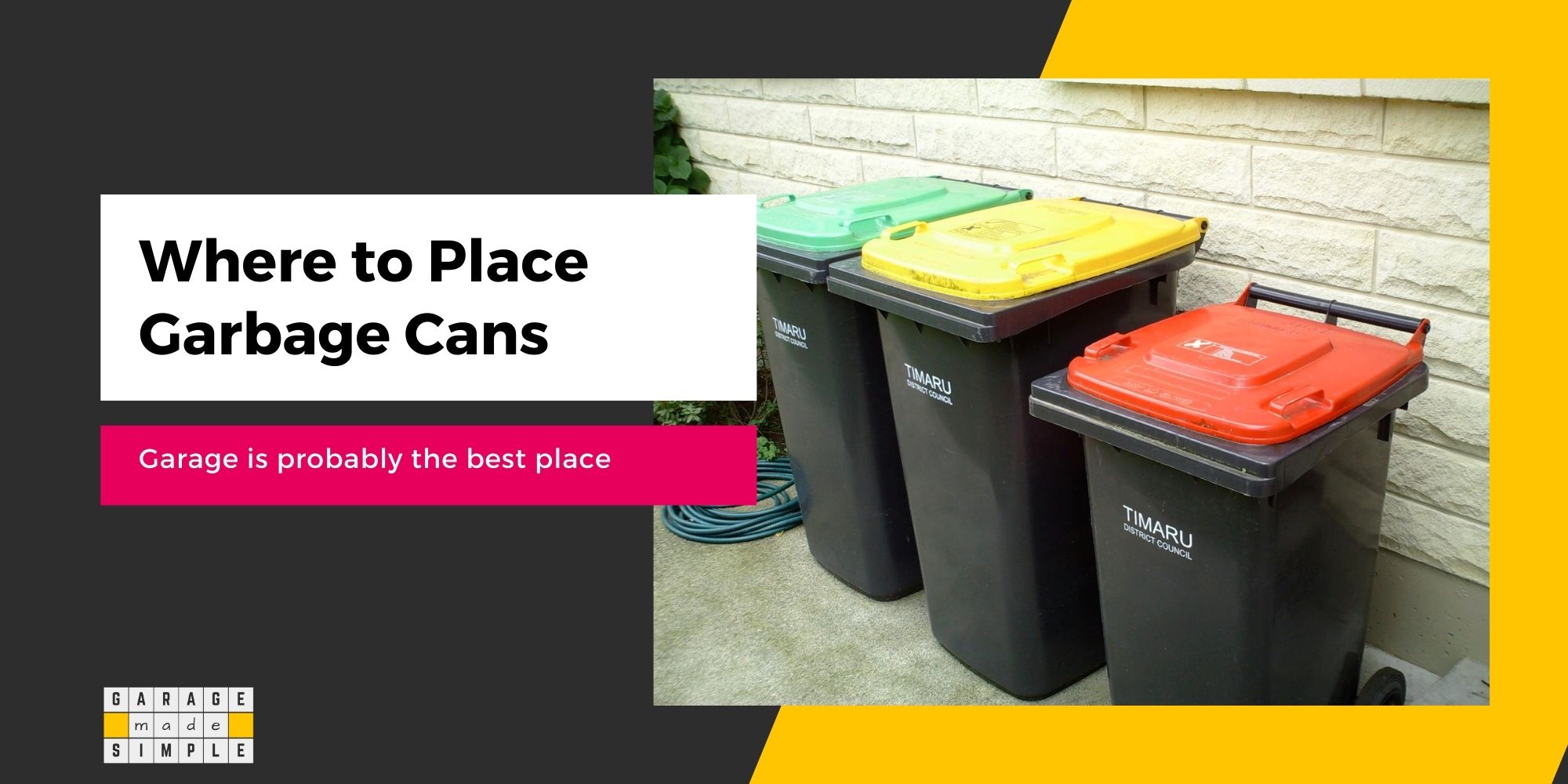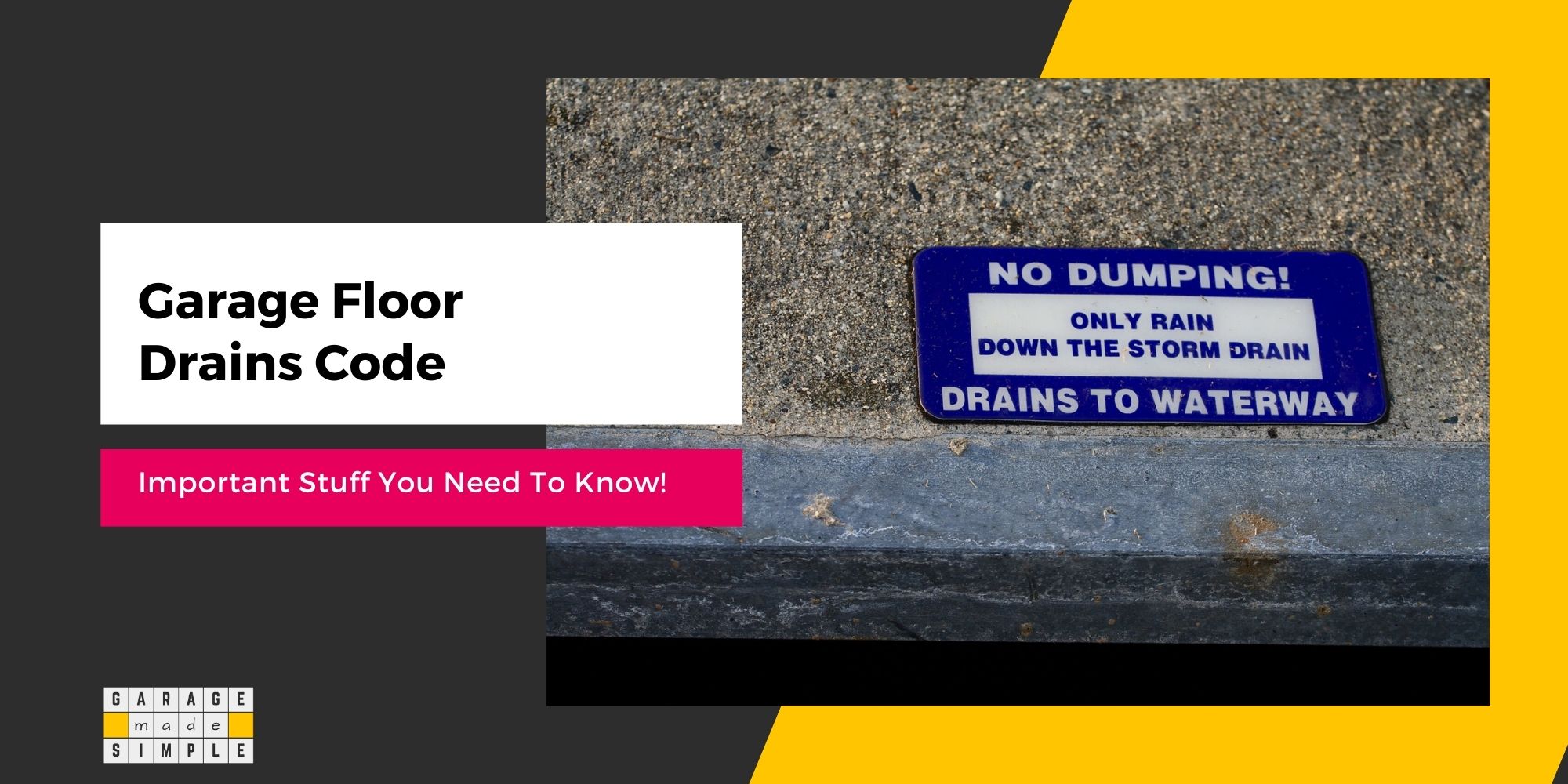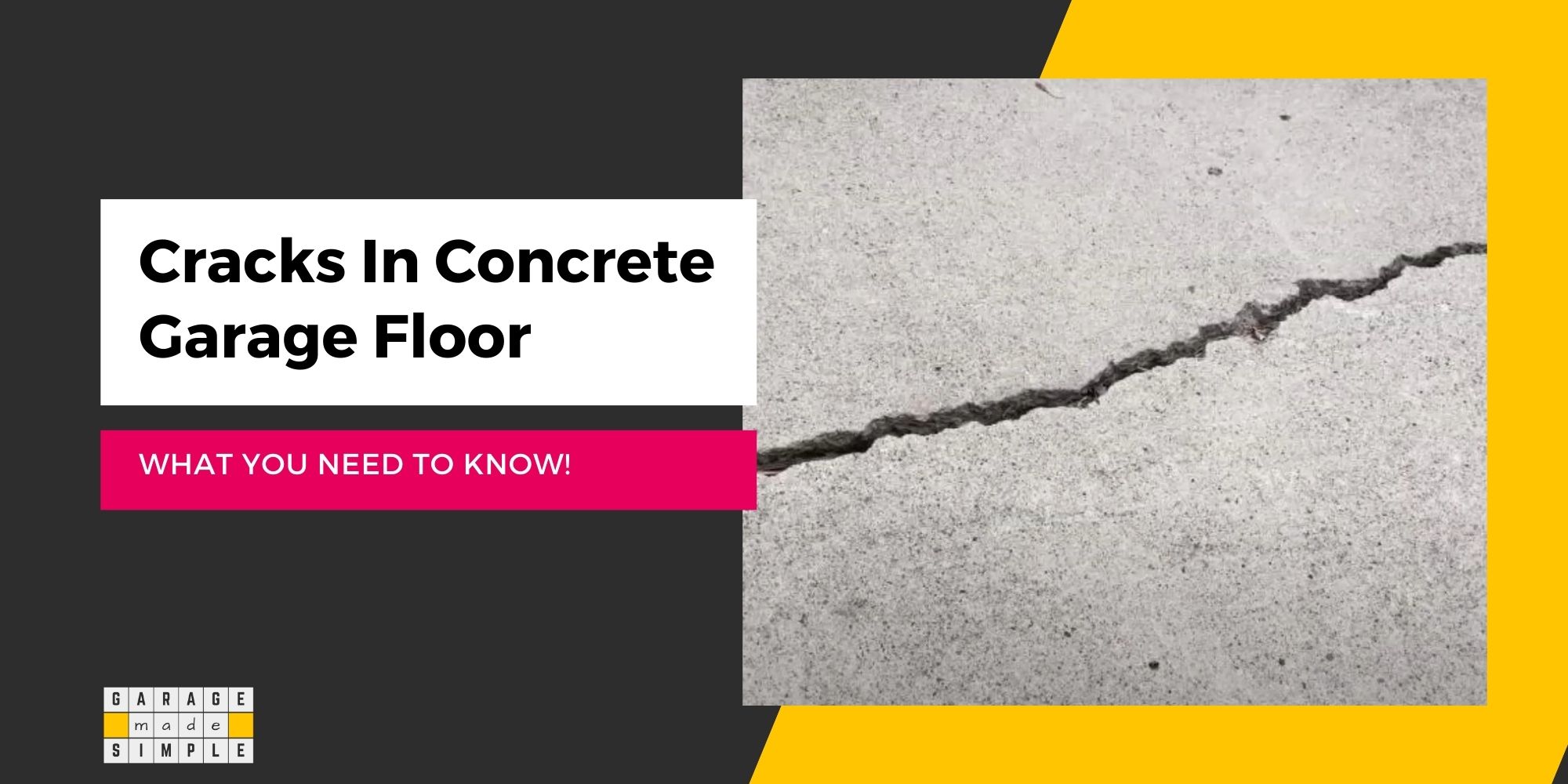How To Get Rid Of Mold From Garage Walls? A Comprehensive Guide
garagemadesimple.com is a participant in the Amazon Services LLC Associates Program, an affiliate advertising program designed to provide a means for sites to earn advertising fees by advertising and linking to Amazon.com . The website is also an affiliate of a few other brands.
How To Get Rid Of Mold From Garage Walls?
Mold growth on garage walls is very distressing, yet a common occurrence. Mold needs an organic food source, high moisture, some warmth, darkness and poor air circulation to thrive. Your garage walls often provide all these. So how to get rid of mold from garage walls?
To get rid of mold from garage walls you need to:
- Understand Mold & Mildew – there are many types
- Be on the Lookout for Mold – before it covers a large area
- Get Rid of the Mold Spores – the sooner the better
- Take Preventive Action – you do not want them coming back
Mold spreads fast! So you need to act fast too!! Get rid of mold from garage walls, as soon as you see the first signs of mold growth.
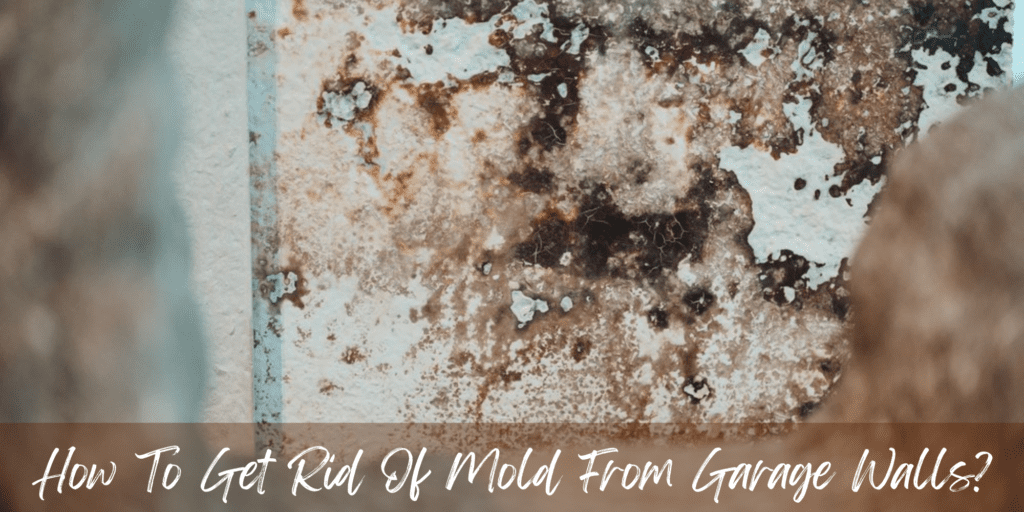
Both mold and mildew are fungi.
Mold is green or black with a fuzzy or slimy texture. Mold can grow inwards too, especially in porous wall sheathing surfaces such as drywall. Mildew is typically white, gray or yellow with a fluffy or powdery texture. Mildew tends to remain on the wall surface.
What Causes Mold in the Garage?
While mold can grow in several parts of the house, such as the basement, bathrooms, kitchen, etc. mold in garages can be a persistent headache.
Mold spores are in the air, everywhere, all the time. All they need is the following conditions to make them flourish:
- High Humidity
- Organic Food Source
- Warm Temperatures
- Lack of Bright Lights
Here are the key reasons why mold growth in the garage is more frequent.
1. Easy for Mold Spores to Enter
Mold spores can be spread by wind, insects, animals, water, yard tools, and other methods. The period between early spring and fall, with higher temperatures and precipitation, is prime for mold growth.
It is easy for mold spores to enter the garage as the big garage door may open and close several times during the day
2. Wide Entrances also let Water In
Garages have broad entrances that permit both vehicles and water to enter during heavy precipitation, making the garage more vulnerable to mold growth.
3. Wet Items Stored Inside the Garage
It is common to store wet items in the garage. You may be storing wet yard equipment, such as lawn mowers and snowblowers. You may store wet tents and other camping equipment in the garage without drying them out first.
Similarly, more often than not we may just dump wet surfboards or kayaks in the garage. Wet sweaty sports clothes, gym accessories are other items that may be stored in the garage without being cleaned and dried.
As a result the garage ends up having high moisture content in the air. Excess moisture and high humidity, foster mold growth.
4. Mold Grows on Organic Surfaces
Once mold spores settle on a wet surface, it takes 24-48 hours for mold to start growing. Organic matter like wet cardboard, decaying wood, garbage in garbage bags and soiled clothes are favorite surfaces for mold to grow as they are food sources.
5. Lack of Natural Light and Ventilation
Most garages, especially unfinished ones, lack adequate natural light and ventilation, creating ideal conditions for mold to thrive.
What are the First Signs of Mold on Garage Walls?
Mold may become visible in a couple of days. Within a week you will have an outbreak.
Since mold grows in dark corners they are difficult to spot. You are likely to smell mold growth, even before you see it. If mold or the mildew are present and thriving in your garage, you will notice the unmistakable musty smell associated with them.
Mold flourishes in humid conditions. Garage walls can be damp due to condensation, water leakage, rain, flooding etc. So you have to do a more thorough inspection of areas that are prone to high moisture and after heavy rains or garage flooding.
Some areas that are more likely to encourage mold growth are
- Garage floor and drywall gap as ground water outside the garage can seep in and wick into the drywall
- Garage ceiling and wall joints as the roof may have developed leaks
- Under air conditioners and utility sinks, around drains & gutter spouts
Keep an eagle eye on these spots.
Types of Mold Typically Found in Garages
Below is a Table of some of the common types of mold that you may come across in your garage.
| Type of Mold | Characteristics | Health Risk | Removal Practice |
|---|---|---|---|
| Stachybotrys (Black Mold) | Greenish-black, slimy texture, found on damp materials. | Severe respiratory issues, allergic reactions, neurological problems. | Professional mold remediation is recommended. |
| Aspergillus (Yellow Mold) | Generally Bright Yellow, sometimes Green, powdery texture, common in food and AC systems. | Allergies, respiratory infections, lung inflammation. | Professional mold remediation and use of mold resistant materials recommended, improve ventilation, use air purifiers. |
| Cladosporium (Green Mold) | Olive Green or Brown, suede-like texture, grows on fabrics and porous materials. | Respiratory issues, skin rashes, sinusitis. | Clean affected surfaces, improve ventilation. |
| Sclerotinia (White Mold) | White in color, powder-like texture, grows on all organic surfaces. | Respiratory issues, Allergies. | Remove by scrubbing with soap water. |
| Penicillium | Blue or green, fuzzy texture, found on water-damaged materials. | Allergies, asthma, sinus infections. | Remove affected materials, reduce humidity, use HEPA air purifiers. |
| Alternaria | Dark green or brown, velvety texture, common in damp areas like showers. | Allergies, asthma, respiratory infections. | Clean affected areas with bleach, fix leaks, improve ventilation. |
What Safety Measures Should You Take When Handling Mold?
Before you embark on the project of removing mold from your garage walls you must take certain safety measures. Removal of mold creates air borne dust rich in mold that can be extremely harmful if it gets into your respiratory system.
This is a serious matter so I prefer to quote an authoritative source (NC Department of Health and Human Services).
To minimize exposure and/or potential health risks from conducting a mold remediation project, take the following precautions:
- Wear respiratory (nose and mouth) protection when handling or cleaning moldy materials. The minimal type of breathing mask, or respirator, that should be used for protection from mold particles is an N-95 particulate respirator approved by the National Institute for Occupational Safety and Health (NIOSH).
- Wear protective clothing that can be laundered or discarded after the project.
- Wear gloves and eye protection.
- Follow the recommended mold cleaning and removal steps to minimize dust dispersal (see Moldy Non-porous and Semi-porous Materials and Moldy Porous Materials).
In addition make sure to
- Cover the floor and surrounding areas with plastic sheets (which should be discarded after the job is done). This is to ensure safe and quick clean up of mold spores.
- Ensure proper ventilation in the work area. You do not want to breathe in the mold spores.
The YouTube video below is a good guide too!
How to Remove Mold from Garage Walls?
You need a slightly different technique to remove mold from garage walls, depending on the type of wall and the extent of mold growth.
1. How to Remove Mold from Painted Garage Walls?
STEP 1: Move out everything around the affected area and lay a plastic sheet on the floor. It will be easier to collect & dispose off the mold spores.
STEP 2: Mix some dish washing liquid soap with warm water. Clean the mold infected area of the garage wall with this solution. It will not kill the mold but make the next step easier.
STEP 3: You can use any mold cleaner spray available at the store. You can also make it at home by mixing one part bleach to three parts water. A milder version uses one part of baking soda in five parts of water. Spray this on the mold and wipe clean with a rag.
STEP 4: Then spray again and wait for 10 minutes. Scrub with a soft stiff brush to remove the mold. You may have to repeat this process if the mold growth is deep seated. Finally wipe clean with another rag.
STEP 5: Wash the painted wall with clean water and let it dry. Use a fan or a blower, if required.
STEP 6: Touch up the area with stain blocking primer & paint.
2. How to Remove Mold from Plywood or OSB Garage Walls?
Plywood and OSB are organic building materials (made from wood) and are also hygroscopic (will absorb moisture). Mold which starts off on the surface can grow inwards and take root.
The process of removing mold from Plywood or OSB garage walls is similar to the one described above with one difference.
Bleach or baking powder solutions are quite often not effective for removing mold from plywood or OSB garage walls. You may need to use distilled white vinegar solution instead. Lightly sand the really stubborn spots where the mold has penetrated deeper.
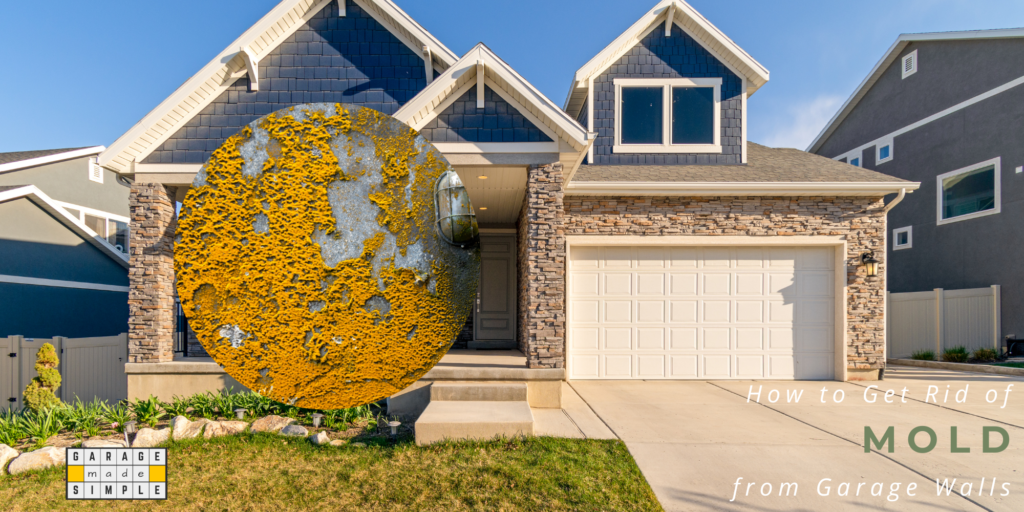
3. How to Remove Mold from Drywall Garage Walls?
Drywall is basically powdered gypsum held together by two sheets of paper, like a sandwich. The paper is the food for mold and it basically grows on it.
The bottom end of the drywall in a garage wall is most prone to getting wet due to condensation or water pooling on the garage floor.
Standard chlorine based mold cleaner or a bleach solution will work fine if you detect the mold growth in early stages.
If the mold growth is in an advanced stage and has penetrated deeper, you will need to use undiluted white vinegar.
Vinegar has a strong odor, but don’t worry. It will dissipate with time.
Flooding or water pooling due to leakage can have more serious consequences. Gypsum is porous and large sections of the drywall will get damp due to wicking.
So the paper on the other side would be wet too and mold can grow where you can’t see it.
STEP 1: Carefully cut out and remove the affected section of the drywall.
STEP 2: Bag the cut out piece and dispose.
STEP 3: Replace the cut out part with a new drywall piece.
If the damage is extensive, you may have to replace the entire drywall. Consider getting a specialist at this stage. Also consider using a less porous, mold resistant building material as an alternative to drywall.
How to Prevent Mold Growth on Garage Walls?
Mold spores are in the air, everywhere, all the time. You can’t do much about that.
Food for the mold in the form of organic building materials such as drywall, plywood, wood or paint are part of the garage. You can not eliminate these.
But you can take some steps to reduce some of them. For example, you could use cement boards instead of drywalls.
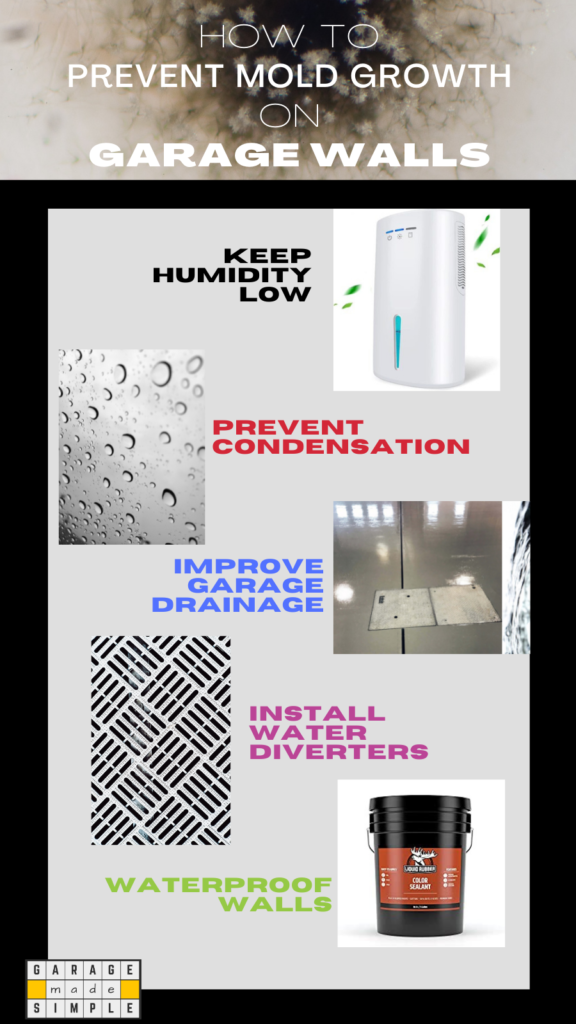
Control of moisture, however, presents the biggest opportunity in preventing mold growth on your garage walls.
“Molds are part of the natural environment, and can be found everywhere, indoors and outdoors. Mold is not usually a problem, unless it begins growing indoors. The best way to control mold growth is to control moisture.”
EPA
1. Keep Humidity Low in the Garage
Your garage can have a high level of humidity, condensation, water seepage, water pooling or even flooding. You need to stop all these from happening. You have to keep your garage dry to prevent mold growth.
A climate controlled garage with a dehumidifier will keep humidity within acceptable levels.
2. Prevent Condensation
Condensation takes place when warm air within the garage is in contact with cold walls. Even condensation on the garage floor will wick up garage walls and make them damp. Condensation promotes mold growth on garage walls.
You can prevent condensation, by better insulation and air circulation within the garage.
3. Improve Garage Drainage
Water pooling can take place if the garage floor slope or garage drainage is not adequate.
Garage floors get wet because of rainwater and snow brought in by the cars, car washing within the garage, plumbing leaks, etc.
Your garage floor should slope outwards so that any water that pools can flow out naturally. It is best to have a drainage system in the garage to clear the accumulated water quickly.
4. Garage Floor Water Diverter
It is equally important that water from outside the garage does not enter the garage. For this you need garage floor water diverters.
You can install drains on the driveway where it meets the garage door to trap rainwater before it can enter your garage.
5. Waterproof the Garage Walls
To keep the garage walls dry, you should waterproof them. The best time to take care of waterproofing the house foundation is at the time of construction.
Waterproofing of garage walls can be done at a later stage too. It involves digging up the soil outside the garage to expose the entire foundation and a few inches of the footing.
The entire foundation wall from say 6 – 12 inches above the soil level to the bottom of the exposed footer level should be coated liberally with Liquid Rubber.
Thank you very much for reading the post. I do hope you found it informative and useful.

